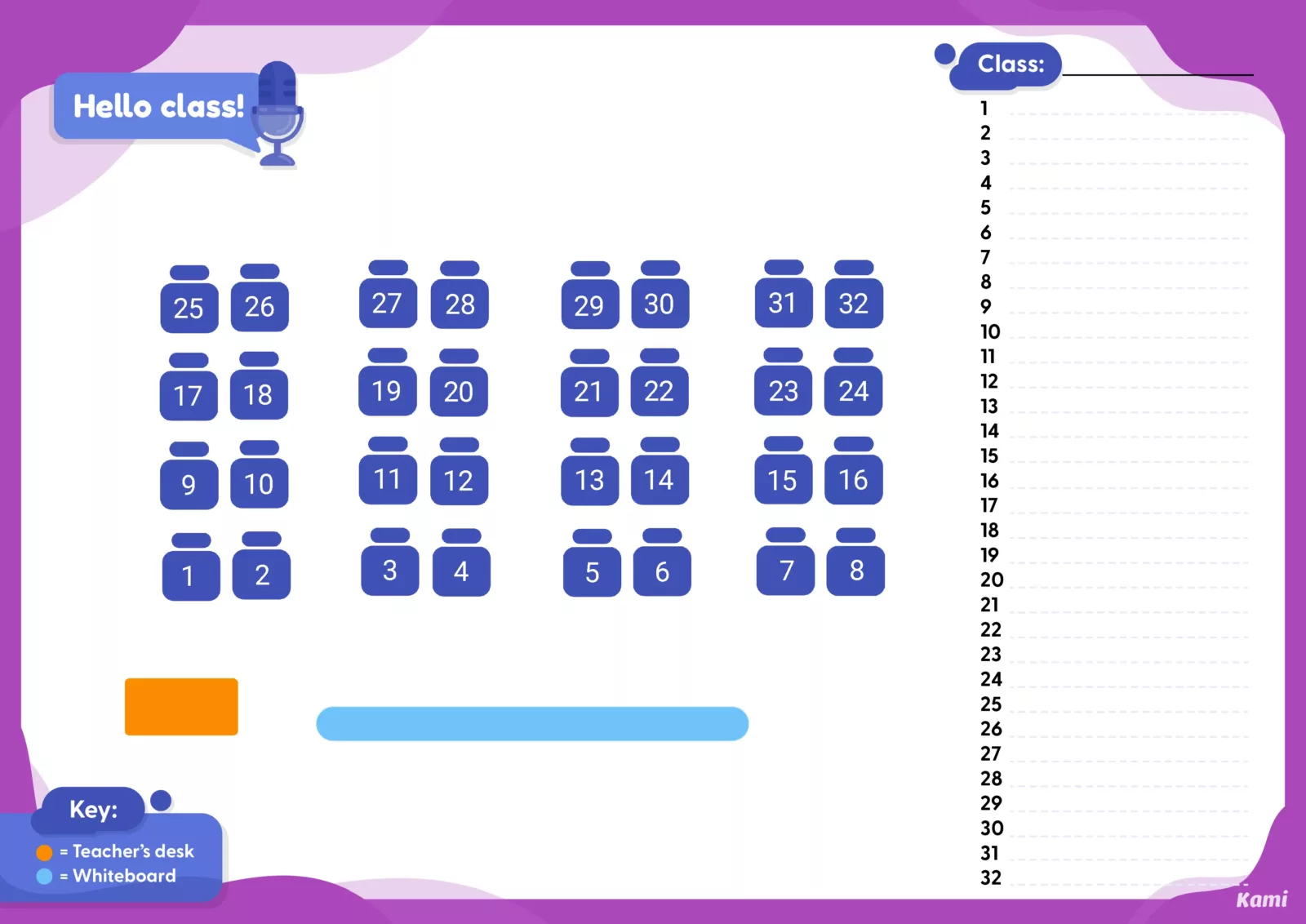Make your first day back a breeze with an interactive and customizable seating chart.
With so much to plan and prep for Back-to-school, the finer details can often get overlooked. But, in the moment, these “finer details” often have a huge impact on whether you’re starting your school year off on the right foot!
We’re talking seating arrangements!
These charts are a simple resource that can help you organize, finalize and memorize your brand new class; the students in it; and just as importantly, how to properly pronounce their names!
Kami Seating Charts
Create a fun, engaging, and inclusive classroom with your very own interactive and customizable seating chart!
Download yours below, or visit the Kami Library for more teaching templates just like these!



As we all know, it can take days, or even weeks, for some students to settle into their new surroundings, figure out their friends, and get comfortable enough to let their personalities shine. (Then there are others who’ll let you know exactly who they are from day one!) That’s why a rearrangeable seating chart can be so beneficial.
Our very own Teacher Success Champion, Marcus Stein, has plenty of know-how when it comes to setting up your classroom seating plan, and what you’ll need to consider while making one.
Take it away, Marcus…
“The first time I created my class seating charts, I placed students in 5 rows of 5 desks.
I arranged the students in alphabetical order by their last names. With this system, I always knew my students’ names and where each student should be at any given time. The simple alphabetized system was also helpful when keeping track of individual student participation.
But after implementing this easy-to-create seating chart, I started to notice student personality clashes: for example, my go-getter students would often stifle the voices of my introverted students. I also noticed that student siblings brought their love/hate dynamic to classroom interactions. On the other hand, I saw students from opposite sides of the room form strong, supportive bonds during class discussions.
So, after about two weeks, I rearranged my seating charts to place supportive students near each other. I moved my bossy, dominant students further away from the quiet students – and the disruptive students earned special seats right next to my desk.
And this intentional change definitely helped my lessons stay on track. When a student disruption started to brew, I would be in proximity to diffuse it. When we would have class discussions, I was able to be more equitable with my own engagement because I spread out my introverted and extroverted students.
The lesson I learned? While an alphabetical seating chart is logistically ideal for me, it was wiser for me to intentionally arrange my students by learning styles, personality types, and exceptionalities because it reduces disruptions and ultimately maximizes instructional time.”
Marcus Stein, Teacher Success Champion at Kami
Using the Kami seating chart
Here’s how to get started with a Kami Seating Chart:
– Open your copy in Kami.
– Have a play with what’s there, delete what you don’t need, or add more desks. Using the Select Annotation tool, just click on a desk to copy/paste/rotate!
– Once you have your arrangement, place your students’ names down the side, on the numbered list.
– Using the voice or video tool, click on the greeting and record a warm welcome.
Tip: Here you can get students excited for the year ahead and introduce them to their temporary seating arrangement.
– For name pronunciation: ask students to add a voice comment on their desk and introduce themselves!
Tip: Ask them to include any other useful or fun info you’re interested in, e.g. a favorite color, animal, or even their preferred pronouns.
– Add these instructions and any other comments to the Instructions Page provided, e.g.“Locate the toolbar on the left and select the Comment tool, then choose Voice Comment. Click on your desk to start recording. When you’re done, press stop. If needed, move your comment to make sure it’s sitting on your assigned desk.”
Tip: You can always screen record this process for them too!
– Add your own voice comment to your desk as an example: “Hello, I’m Mr. Stein, and my favorite color is purple!”
– Once you’ve annotated all introductions and instructions, it’s time to share the chart with your class! Click on the Share Document button in the top right corner and make sure it’s set to Anyone with the link and Editor. Copy the link and send it to your students. It’s as simple as that!
Why use a seating chart?
Considered arrangements
Falling back on alphabetical seating plans can be super useful for you, but not always for your students. Clashes of personalities can lead to disrupted learning, motivation, and focus if a student isn’t placed in a supportive structure that lets their unique learning style thrive. Rearranging your seating plan once you get to know your students not only means their needs can be met but how you interact with students can then be considered e.g. disruptive students earn seats within earshot!
Proper pronunciation
Having a place to record and memorize name pronunciation is super important. Studies have shown that a students’ socio-emotional well-being and worldview can be negatively impacted by teachers who don’t take the time to pronounce their names properly. It can even result in children shying away from their own cultural identity. With Kami, you can get the students to drop records of themselves saying their own names onto your seating chart, so you’ll never have to guess!
Flex your creativity
There’s a whole heap of ways to arrange your class to best suit your size and space available. And using our interactive seating resource, you can chop and change the template however you like to match whatever classroom you create!
Here are some ideas to get you started:
Inspired by: Yale. Read more about these arrangements, here.
Linked Resources
Seating Charts:
Chart: Groups
Chart: Horse Shoe
Chart: Rows
Instruction Page
Read about the importance of seating arrangements.
Read more on proper name pronunciation and its value.
Blogs you may also like

How Jeff Kilner and His District Transformed Teaching with Kami

Welcoming Book Creator to the Kami family



